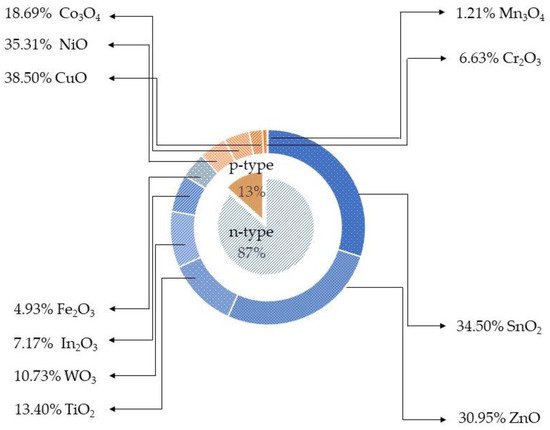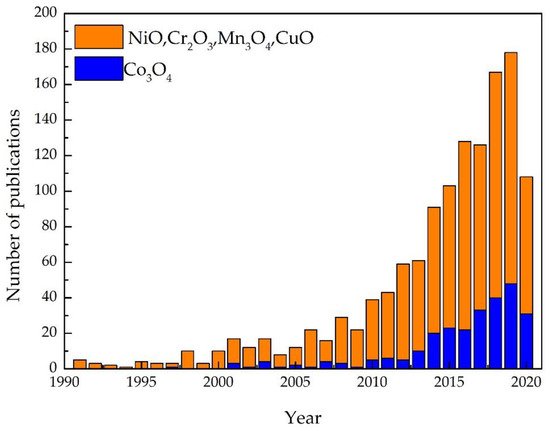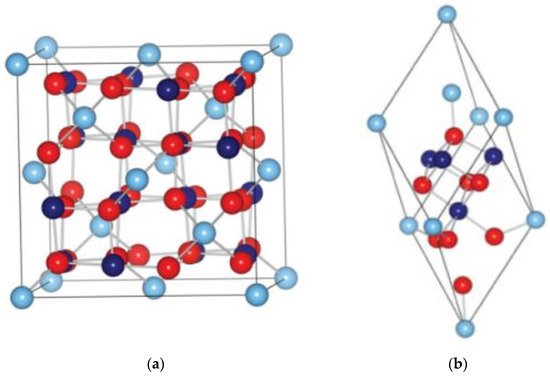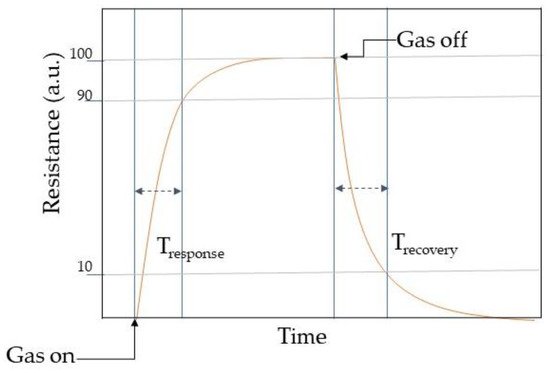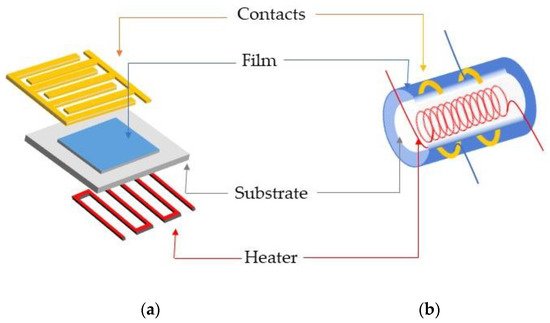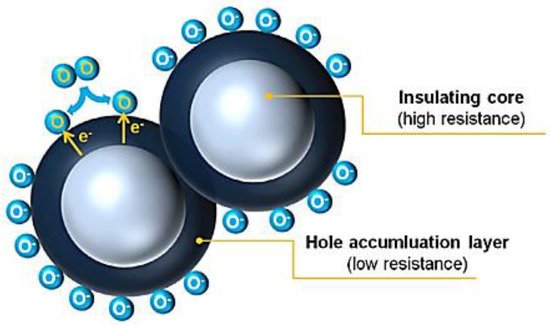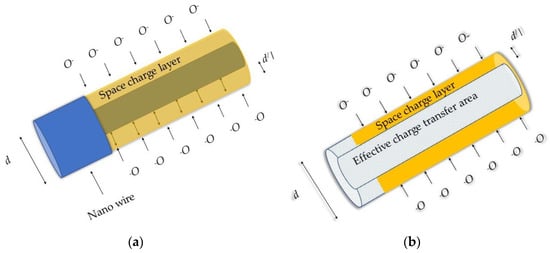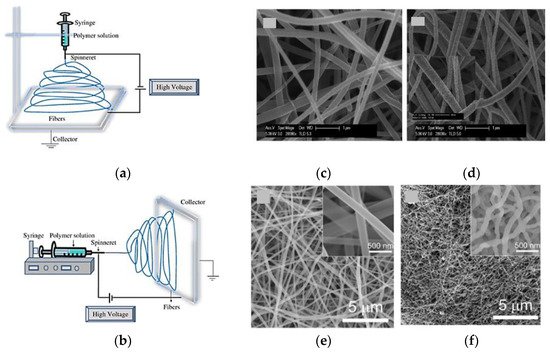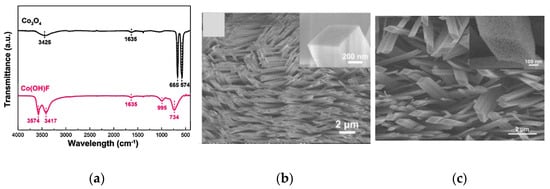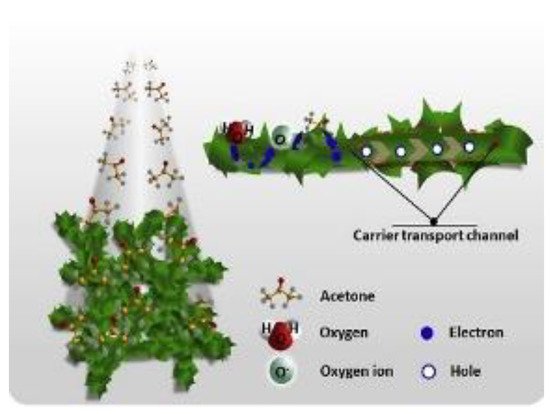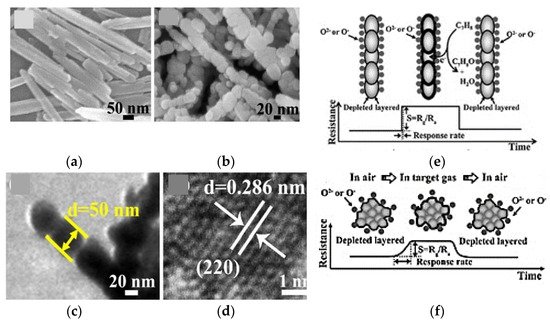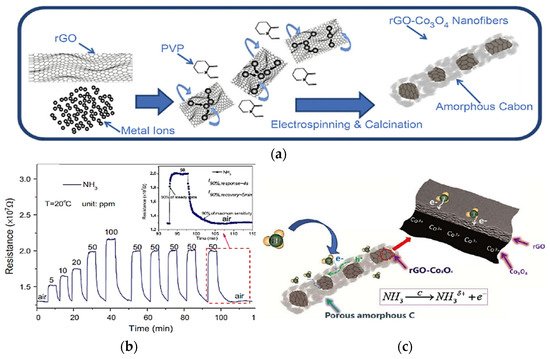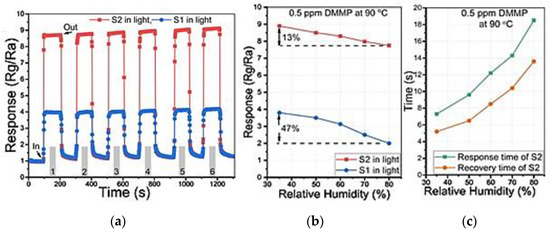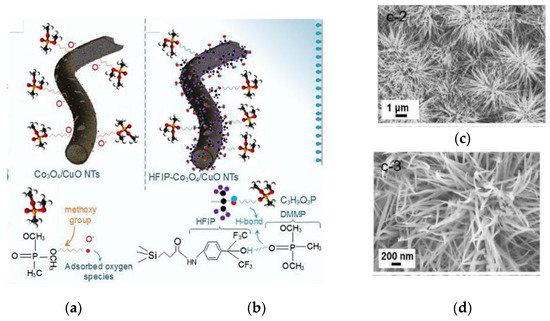Ethanol is a VOC that is vastly present in the daily life of human beings in means of food, beverages, fuel-processing, pharmaceutical, as well as in many laboratories and industries for diverse research and applications
[72]. However, the long-term exposure to C
2H
5OH has been identified as the main reason for serious health effects such as lethargy, irritation to skin and eye, difficulty breathing, coma, liver damage, and intoxication. Moreover, C
2H
5OH as alcoholic drink has been identified as one of the root causes for the rising traffic accidents around the world
[73]. For this reason, almost all countries have legalized the consumption limitation of C
2H
5OH. For example, in Italy the highest ethanol level that is allowed in the breath of drivers is 130 ppm (0.05% in blood) while in the USA, 208 ppm (0.08% in blood)
[74]. Hence, detection and quantification of C
2H
5OH in environment as well as in human breath have become a necessity. Before discussing the C
2H
5OH-sensing applications it would be interesting to understand its sensing mechanism at MOXs surface. When ethanol is interacting with the near surface irrespective of the type of MOXs sensor, these molecules are chemisorbed on the MOXs surfaces. Afterwards, chemisorbed ethanol molecules start to react with the adsorbed oxygen species resulting in the formation of H
2O and CO
2. Hence the trapped electrons are liberated back to the MOXs altering the sensor resistance. The chemical reaction between C
2H
5OH and adsorbed oxygen species on the near surface of the MOXs is described as in (4–5) regardless of the type of the MOXs
[74].
Among the synthesis techniques for Co
3O
4 NRs preparation, solvothermal technique one has been used to prepare C
2H
5OH-sensing devices by Choi et al. in 2010
[3]. The integrated sensors by the Choi et al. have demonstrated a superior selectivity and response to 100 ppm of C
2H
5OH compared to that of H
2 and CO at 300 °C. Furthermore, the effective and prompt diffusion of gases onto the whole surface Co
3O
4 nanorods give rise to a superior response of 25.4 (R
a/R
g) to 100 ppm C
2H
5OH together with the response time of 29 s and recovery time of 10–13 s compared to the one of nano cubes and particles
[3].
It is known that the morphology of the nano structures can be altered depending on the original material, the growth technique, and its parameters. Wen et al. in 2013 have addressed the growth of Co
3O
4 rhombus-shaped NRs on polycrystalline alumina ceramics plate, investigating their C
2H
5OH detection capabilities
[25]. They have also demonstrated the necessity of post treatment annealing step for the hydrothermal-assisted growth. This additional step is known to support the removal of adsorbed water molecules upon calcination
[25]. Wen et al. have shown the absence of FTIR peaks of O-H (3574 cm
−1 and 1635 cm
−1), O-H groups interacting with fluoride (3417 cm
−1), Co-OH (995 cm
−1), and Co-F (734 cm
−1) vibrations in the calcinated sample compared to that of the as-grown one (
Figure 11a). Additionally, dehydration and lattice contraction may also occur during the thermal treatment, causing a topology modification of more rough surfaces (
Figure 11b,c). Furthermore, the rougher topology along with the unique structure of Co
3O
4 NR arrays, the high surface to volume ratio, the actual participation of each NR for the gas sensing due to the direct growth of Co
3O
4 NRs on substrates and the space between individual NRs has been identified as the main roots of outstanding sensing performances
[25]. Moreover, these unique features have also tuned the sensor toward breath analysis application and extended stability
[25].
Figure 11. FTIR spectra of the Co
3O
4 NRs: (
a) before and after sintering at 450 °C; (
b) SEM images of Co(OH)F NR; (
c) SEM image of the rhombus-shaped Co
3O
4 NR arrays annealed at 450 °C. Reprinted with the permission from
[25].
Nguyen et al. have reported the occurring of rough and porous nature in the topology on the NRs upon the calcination
[24]. However, the porous morphology has been attributed to the oxidation of Co(OH)
x(CO
3)
0.5.0.11H
2O in the as grown material. Furthermore, Nguyen et al. have observed the necessity of higher amount of oxygen vacancies [Equations (4)–(6)] for an effective ethanol detection. Co
3O
4 NRs sensors show higher responses toward ethanol at 300 °C in ambient air compared to N
2 environment due the reduction of pre-adsorbed oxygen in the Co
3O
4 in N
2 environment.
Electrospinning has been employed for the preparation of nano fibers (NFs) for the detection of C
2H
5OH by Yoon et al.
[65]. The sensors have shown superior sensitivity (R
g/R
a = 51.2) toward 100 ppm of C
2H
5OH compared to CO, C
3H
8, and H
2 at 301 °C before decreasing to 19.2 at 336 °C. While the recovery time was decreasing as the operating temperature increases due to the thermal boosting of oxygen ionization.
Furthermore, Yoon et al. have demonstrated the effect of NFs dimension in the sensing properties in 2014
[63]. In the reported study three sets of NFs were grown by altering the ultrasound sonication time using the electrospinning followed by calcination. The sensor resistance has been found to increase with the sonication time due to the reduction of the effective surface area. This decrement resulted from the breaking of well-connected long nanofibers into less connective nanoparticles or shorter fibers. Additionally, the variation in the contact area among the particles has been identified as a possible reason for the decrease in the response with higher duration of sonication. Hence, the inter-particle connectivity could be a significant parameter for the gas-sensing performances in Co
3O
4 devices.
The detection of lower concentrations is highly beneficial when considering safety applications. One successful study has reported the detection of 10 ppm C
2H
5OH exploiting needle shaped Co
3O
4 nano arrays (
Figure 12a) that were grown in facile hydrothermal route by Wen et al. in 2014
[34]. The reported nanoneedles array has demonstrated mesoporosity and quasi-single-crystalline structure which has been identified as the main motivation for the superior response of 89 (R
g/R
a) toward 100 ppm ethanol at a working temperature of 130 °C (
Figure 12b). Furthermore, several other key factors, such as the strong adhesion between the sensing materials and the substrates, which in turn improve the good ohmic contact, the random orientation of the nanoneedle arrays and the special exposed crystal planes of Co
3O
4 have been ascribed for the superior sensing performance and their stability.
Figure 12. The SEM image of Co
3O
4: (
a) nanoneedle arrays; (
b) the dynamic response and recovery plot of the Co
3O
4 toward ethanol. Reprinted with the permission from
[34].
4.2. Sensing toward Acetone (C3H6O)
Acetone is a VOCs known to be caused by irritation to nose, eyes, throat, and central nervous system as the concentration is higher than 173 ppm or if the exposure continues for several hours
[60][72][60,72]. Moreover, it has been identified as a key compound to identify health issues in human body by analyzing the human breath
[67][75][67,75]. Hence, the detection of acetone is essential for both society safety and health. An illustration of C
3H
6O detection mechanism on nanofibers is shown in
Figure 13 [52]. A superior sensitive and selective performance toward acetone has been reported by Choi et al. on Co
3O
4 NFs composite with Ir NPs and graphene oxide (GO) sheets in 2014
[66]. Co
3O
4 NFs, have been grown by electrospinning technique while the GO sheets as well as Ir NPs were grown by the polyol method
[68]. The composites NFs (1 wt% Ir-GO-Co
3O
4) were able to detect acetone even at 120 ppb in highly humid ambient conditions (90% RH) demonstrating great potentialities for acetone analysis in human breath
[66]. In addition, the sensors have shown excellent selectivity toward acetone other than the usual breath biomarkers; pentane, NO
2, NO, NH
3, and CO. One of the reasons for these excellent performances is the combined catalytic effect of GO sheets and Ir NPs. A second one is the hole accumulation layer thinning on the surface of Co
3O
4 NFs due to Ir NPs together with the effective electronic sensitization by the GO sheets. In addition, the rapid transfer of carrier to the sensing electrodes, due to the highly conductive GO sheets, contributed to improve the performances.
Figure 13. The illustration of sensing mechanism of C
3H
6O on Co
3O
4. Reprinted with the permission from
[52].
Another interesting morphology for chemical compounds detection is one of the hierarchical nanofibers (HNF). Its effective surface area is outstanding and there is a smooth transfer of carriers through nanofibers without additional barriers, due to the connection of the nanosheet-like structures in the nanofiber
[52]. In 2019 Cao et al. have demonstrated C
3H
6O sensing with HNFs at an operating temperature of 190 °C. The grown HNFs comprised many nanosheets with smooth surface almost perpendicular to the nanofiber’s surfaces (thickness of 20–40 nm) as shown in
Figure 14a–c
[52]. However, Zhang et al. have reported the possibility of detecting C
3H
6O at an operating temperature of 75 °C with Co
3O
4 NWs assembled on hollow carbon spheres (Co
3O
4 NW-HCS)
[23]. The enhanced sensing performances at low operating temperature have been attributed to the interaction between hollow carbon spheres and short Co
3O
4 nanowires. Moreover, the unique porous cavity structure of hollow carbon spheres is contribute to the excellent sensing performances by paving higher number of available sites for easy adsorption and desorption of C
3H
6O molecules.
Figure 14. The SEM micrograms: (
a–
c) HNF of Co
3O
4. Reprinted with the permission from
[52].
4.3. Sensing toward Carbon Monoxide (CO)
The World Health Organization has announced that 92% of the world’s population live in zones with poor air quality
[69]. Consequently, the lack of air quality has been identified as the reason for the increment of the premature death worldwide
[69]. CO is one of the major air pollutants. It is a byproduct of the incomplete combustion process of fossil fuels, from power stations (coal), industrial factories, and vehicle exhaust. CO is colorless, tasteless, poisonous, and odorless
[70]. CO has a greater affinity with hemoglobin compared to O
2. Thereby, CO binds easier than O
2 to hemoglobin as it enters into the blood which in turn results in suffocation to death
[71]. Hence CO monitoring in living environments is significantly valuable. Co
3O
4 1D nano structures growth for the detection of CO may be interesting due to its long-term stability, high surface/volume ratio, and low-temperature operation
[16].
Figure 15 shows the interaction of CO on the MOX surface. The sensing reactions can be written as in Equations (6)–(9)
[64].
Figure 15. The schematics of proposed CO detection mechanism: (
a,
b) adsorption of O
2 to the Co
3O
4 surface; (
c) adsorption of CO to the Co
3O
4 surface once it reacts with surface-near lattice oxygen; (
d) the desorption of CO as CO
2; (
e,
f) oxygen vacancies are replenished by oxygen from the gas phase; (
g,
h) replenishment of oxygen vacancies by oxygen from the surface-remote lattice. Redrawn with the permission from
[28].
In 2010 Patil et al. have demonstrated Co
3O
4 NRs sensing of CO with a response of 6.5 to 50 ppm CO at 250 °C
[15]. The NRs sensors have demonstrated a higher response compared to the commercially available NP sensors due to the stronger bonding between nanoparticles in the NRs beside the higher surface-to-volume ratio. Additionally, the fabricated sensors have shown superior selectivity compared to H
2, LPG, CO
2, and ethanol.
However, CO sensing at a low working temperature (100 °C) has been reported by Dou et al. in 2014
[16]. The NFs sensors demonstrated a higher response (~13.5 (R
g/R
a) toward 50 ppm CO. Moreover, the detection of 5 ppm at 100 °C has been reported by the Busacca et al. on NFs Co
3O
4 sensors in the same year
[62]. The excellent CO-sensing response of 2.4 (R
g/R
a) together with response time of 14 s and recovery time of 36 s of NFs was attributed to the higher effective surface area as well as the higher number of oxygen vacancies or defects on the NFs surface. Additionally, the lower crystallite size (about 15 nm) has been identified as one of the potential factors that could enhance the sensor performances. However, the sensor response was saturated at a concentration of 20 ppm at 100 °C owing to the formation of carbonates species at a low temperature that deactivates the action of Co
3O
4 catalysts in CO oxidation.
4.4. Sensing toward Toluene (C7H8) and Xylene (C8H10)
Toluene is another VOC widely used in paints, rubber, adhesives, and printing. Nonetheless, it is toxic, dangerous, and a neurotoxic compound that is damaging to humans even at very low concentrations (88 ppm)
[27][76][27,76]. Owing to these consequences chemical/gas sensors are required to monitor toluene concentration in the afore mentioned applications.
Wang et al. have reported Co
3O
4 NRs-assisted gas sensors for toluene detection
[27]. The grown rods-like structures were oriented from the assembly of numerous fine nanoparticles. The
Figure 16a,b shows NRs with 40–50 nm width and cubic spinel Co
3O
4 phase. The sensors have shown an excellent response of 6 (R
g/R
a) toward 10 ppm of toluene and 35 (R
g/R
a) for 200 ppm at 200 °C together with response and recovery time of 90 s and 55 s respectively. Furthermore, higher sensing response has been obtained in rod-like structure, compared to nanoparticle, due to the higher amount of adsorbed oxygen molecules and the easiest diffusion of toluene through the well-aligned porous structures. This in turn improves toluene molecules absorption in the rod-like Co
3O
4 surface as depicted in
Figure 16c,d. Once toluene molecules interact with the pre-adsorbed oxygen, the following reaction takes place on the surface of Co
3O
4:
Figure 16. The FESEM:(
a) as grown; (
b) calcinated at 450 °C for 3 h; (
c) TEM and; (
d) HRTEM of the calcinated Co
3O
4 nano rods. The illustration of gas-sensing mechanism; (
e) Co
3O
4 nanorods; (
f) commercial Co
3O
4 powder. Reprinted with the permission from
[27].
The released electron will interact with the hole in Co3O4 resulting in the decrease of the carrier concentration (hole), thus increasing the sensor resistance which can be used to study the concentration of interacting chemical compounds.
Sensing properties tunability, such as selectivity toward different gases, could be interesting when considering the production costs. The possibility to detect two gases with the same sensor exploiting different operating temperatures has been demonstrated by the Jeong et al. on Cr-incorporated Co
3O
4 NRs for xylene and toluene
[59]. The responses to xylene of pure Co
3O
4 NRs and Cr-incorporated NRs were found to increase at 250 °C and the sensing properties were tuned toward the toluene as it is working at 300 °C. Additionally, the fabricated Cr incorporated sensor has shown higher selectivity of 5.61 (S
toluene/S
ethanol) and 6.01 (S
xylene/S
ethanol) in the 1.89% Cr-doped Co
3O
4 NRs at 275 °C for a concentration of 5 ppm. The selective sensing of toluene in Cr incorporated sensors has been attributed to the synergetic effect of abundant adsorbed oxygen on Co
3O
4 surface and the catalytic action of Cr for partial oxidation of methyl groups in toluene into a more reactive chemical species for xylene detection. Yet, the fastest detection of xylene was reported for Co
3O
4 1D nano structures NFs by Qu et al. in
[67] with a response and a recovery time of 15 s and 22 s respectively. The reported faster response and recovery times have been attributed to the fast mass transfer of xylene molecules from and to the interaction area, together with the distribution of bimodal pore sizes
[67].
4.5. Sensing toward Ammonia (NH3)
Ammonia is one of the extensively employed chemical in many fields for instance food processing, clinical diagnosis, and fertilizer production. However, direct contact or inhalation of ammonia at lower ppm levels can lead to burn of skin, eyes, lungs. Subsequently, inhalation of very high NH
3 concentration (10,000 ppm) for 3 h may cause death
[77][78][77,78]. Hence detection of NH
3 is important. Beside the existing ammonia sensors that operate at high working temperature (>300 °C), an outstanding NH
3 sensor operating at 160 °C has been reported with the exceptional response and recovery time of 2 s and 10 s, a sensing response of 11.2 for the concentration of 100 ppm
[53]. The reported sensor has been prepared with hierarchical structured Co
3O
4 NRs. The grown NRs were 200 nm in diameter approximately and from 1 to 2 µm in length (
Figure 17a–c). The superior response has been ascribed to the enormous number of active sites and space in the hierarchical nanostructures for adsorption and reaction between analyte gases and adsorbed oxygen ions (
Figure 17d)
[79]. The existence of multiple HALs layers on the surface of hierarchical nano structures may be one of the reasons for this superior sensing performance toward NH
3. NH
3-sensing reaction on the Co
3O
4 surface can be understand as follows.
Figure 17. The FESEM images: (
a–
c) hierarchical Co
3O
4 nanorods; (
d) illustration of the gas detection mechanism. Reprinted with the permission from
[53].
Hence Fung et al. have demonstrated an excellent NH
3 sensor based on reduced graphene oxide (rGO) encapsulated Co
3O
4 composite nanofibers working at room temperature
[71]. Fabricating a sensor that demonstrates outstanding gas detection capabilities at room temperature is among the best achievement when considering energy consumption, stability, portability, and low operation cost. There are a lot of research works focusing on low cost and stable sensors. The fabricated sensors have achieved a response of 53.6% (R
a−R
g)/R
a together with 4 s and 5 min as response and recovery time respectively
[71]. The exceptional room temperature gas-sensing performances can be ascribed to the remarkable NH
3 interaction with the superficial layer of rGO and the polarized C-Co
3+ covalent cores within the porous nanofibers. Furthermore, these sensors show a superior selectivity to NH
3 among the ethanol, methanol, formaldehyde, methylbenzene, benzene, and acetone owing to the different adsorption properties, higher polarity of NH
3, and the coupling effect of Co-C. The schematic illustration of the growth and gas-sensing mechanism is shown in
Figure 18a–c.
Figure 18. The schematic illustration of growth mechanism: (
a) rGO-Co
3O
4 composite nanofibers; (
b) dynamic response toward the NH
3; (
c) schematic diagram of the sensing mechanism of the rGO–Co
3O
4 composite nanofibers toward ammonia at room temperature. Reprinted with the permission from
[71].
4.6. Detection toward Hydrogen Sulfide (H2S)
H
2S is a colorless, irritating, and highly toxic gas. It may lead to strong effects in both visual and respiratory systems at concentrations close to 50 ppm. Furthermore, even a rapid exposure above 100 ppm may induce coma and even death due to respiratory paralysis
[80][81][80,81]. Thereby, a reliable sensor for H
2S detection is necessary to monitor its presence.
Fabrication of Co
3O
4 mesoporous nanochains sensor for H
2S detection has been demonstrated in 2018 by Quang et al.
[82]. The nanochains were obtained by calcinating the hydrothermal grown nanowires at 600 °C for 5 h (
Figure 19a–c). The meso-porosity in the nanochains were ascribed to the elimination of adsorbed water molecules (justified by the total weight loss of 30.5% calcinated/as grown nanochains). The weight change was noticed in 30–200 °C and 200–400 °C temperature range in TG-DTA, corresponding to the removal of absorbed water and oxidation of Co(CO
3)
0.5(OH).11H
2O into Co
3O
4. These nanochains have shown superior selectivity toward H
2S among other tested gases (NH
3, H
2, and CO). Moreover, the response stability was measured over a period of five months and response and recovery time were 46 s and 24 s. Additionally, the principal mechanisms of H
2S detection would be interesting to mention [Equation (11)] to conclude the discussion on H
2S detection
[64][72][64,72].
Figure 19. Morphological features of the mesoporous Co
3O
4 nanochains: (
a) SEM; (
b) TEM; (
c) HRTEM images; (
d) TG and DTA plots of cobalt carbonate hydroxide nanowire. Reprinted with the permission from
[82].
4.7. Sensing toward Diethyl Ether (C4H10O, DEE)
Diethyl ether is a VOC with a pungent smell. It is extensively used as an organic solvent in diesel engine, laboratory, industry, and medicine owing to its low viscosity, and high chemical stability. However, its high volatility and low flash point induce dizziness, headaches, proteinuria, and even death in humans
[30]. Recently, Jiang et al. have demonstrated the potentialities of Co
3O
4 NRs sensors for DEE detection
[30]. They have reported a complete decomposition of CoCO
3 precursor at 355–600 °C in addition to the water and hydroxyl compound elimination reported by Quang et al.
[82]. The prepared sensing devices have demonstrated a response of 110.34 to 100 ppm DEE at 160 °C. This excellent response was attributed to the high effective surface area and mesoporous structure resulting from the complete CoCO
3 decomposition. Furthermore, the mesoporous structure may facilitate both DEE molecules diffusion and adsorption on the Co
3O
4 surface. This in turn enhances the sensor response. A possible REDOX mechanism on the MOX surface is described in Equations (13) and (14).
The sensors have shown an interesting selectivity toward DEE compared to acetone, isopropanol, ethanol, acetonitrile, cyclohexane, chloroform, and ammonia at the same concentration.
4.8. Sensing toward Formaldehyde (HCHO)
Formaldehyde (aldehyde) is a carbonyl species, a colorless gas, and soluble in organic solvents. It is carcinogenic for humans
[83] and one of the main reasons for “sick building syndrome” (SBS) and “new car smell.” It causes symptoms such as headache, dizziness, fatigue, and irritation of the general sensory systems and central nervous system damage. World Health Organization (WHO) has limited the exposure beyond 0.08 ppm toward HCHO even for a short-term period (30 min) to avoid sensory irritation
[84]. Therefore, HCHO concentration monitoring is highly demanded in all environments.
Co
3O
4 hollow NTs (
Figure 20a–d), grown from solution phase, were tested for HCHO sensing at 140–220 °C in 2014 by Wang et al.
[85]. A response of (R
g/R
a) 6.3 at 180 °C, together with response and recovery time of 3 s and 1 s respectively, was reported for 50 ppm. The excellent sensing performances were attributed to the distinctive hollow structure and the rough surfaces of Co
3O
4 NTs. Meanwhile, Bai and coworkers have demonstrated excellent sensing performance toward HCHO in Au@Co
3O
4 composite nanowires comparted to pristine Co
3O
4 NWs
[86]. In this study the compact NWs were synthesized via a facile hydrothermal method from the precursor Co(CO
3)
0.5(OH)·0.11H
2O followed by annealing treatment. The nano structured annealed at 400 °C have demonstrated the highest response toward 20 ppm HCHO with a response of 17.25 (R
g/R
a) at an operating temperature of 90 °C. The excellent sensing features have been achieved due to the electron transfer between Ag nanoparticles in the composite and Co
3O
4 as well as the catalytic property of the Ag nanoparticles which accelerate the adsorption and dissociation of gas molecules to enhance the gas-sensing performance. HCHO-sensing mechanism can be described as follows
[86][87][86,87].
Figure 20. Co
3O
4 hollow nanotubes: (
a) The FESEM image; (
b) the TEM image; (
c,
d) elemental mapping images of Co and O, of Co
3O
4 hollow nanotubes. Reprinted with the permission from
[85].
4.10. Sensing toward Triethylamine (C6H15N, TEA)
Triethylamine is a VOCs used as a catalytic solvent, corrosion inhibitor, hardening agent for polymers, and in many chemical syntheses processes
[90]. TEA causes skin and eye burns, headaches, and particularly respiratory awkwardness because of its robust pungency, which can cause pulmonary edema and even death
[90]. It is very flammable hence blending of high concentration of TEA in air can potentially end up with intensive explosions. Thereby it is important to monitor TEA in all environments.
The only study on TEA detection using Co
3O
4 1D-based sensors is reported by Xu et al.
[22]. In the reported study a possible alternation in density, length, and shape of Co
3O
4 NWs arrays has been found depending on the NH
4F concentration of the chemical solution of hydrothermal process (
Figure 22c,d). The best response toward TEA was 4 (R
g/R
a) at 250 °C with little interference of humidity due to its unique superficial properties and high operating temperature. Moreover, the sensor has demonstrated repeatability and stability of the sensing performances up to one month. Moreover, the sensors response (R
g/R
a) results toward ten gases (100 ppm) including ethanol (1.8), methanol (1.6), acetone (1.6), ethyl acetate (1.6), xylene (1.8), propanol (2.0), benzene (1.2), formaldehyde (1.6), ammonia (3.6), and butanol (2.0) have demonstrated higher selectivity to TEA. The sensing mechanism can be identified as bellow
[22].
